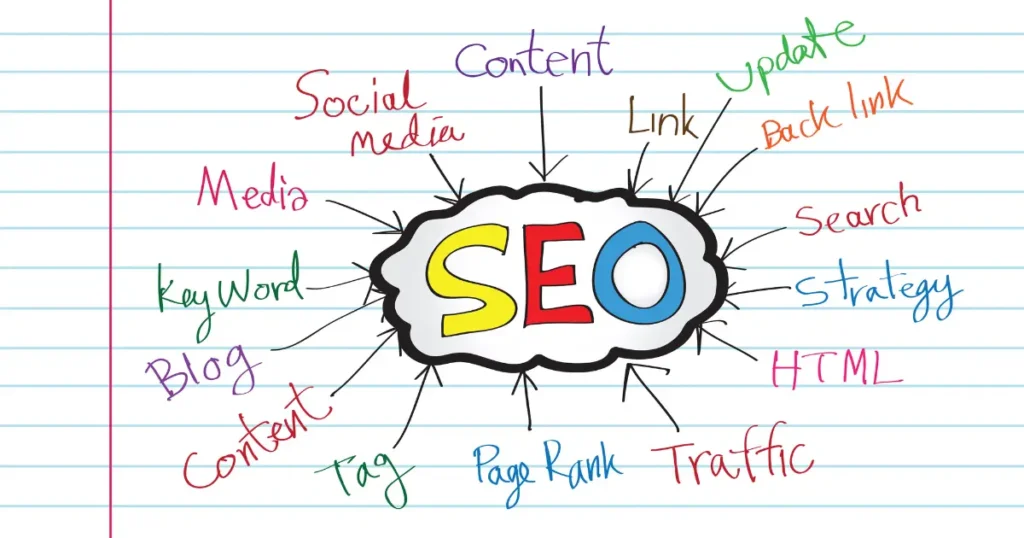
Are you still struggling to rank for your top keywords? The issue might not lie in the quality of your content or the quantity of backlinks you possess.
Your site might be falling behind because of simple SEO mistakes.
SEO mistakes are unfortunately common, and the unfortunate reality is that your site will not achieve a good ranking as long as these issues persist. Fortunately, they can be easily resolved.
In this article, I will show you how to identify and correct SEO mistakes. I will discuss the 13 most frequent search engine optimization mistakes I encounter on websites, clarify why they pose issues, and show how you can fix them.
Learn more about The Best Ecommerce SEO Company in 2025
Why It’s Important to Avoid SEO Mistakes
SEO mistakes can adversely impact a website’s performance. Common SEO mistakes can lead to wasted time and resources by resulting in low search engine rankings, which in turn affect organic traffic. Users may struggle to locate your site, which can diminish visibility and impact potential sales.
Some of the most common effects include:
- Misallocated Resources: Common SEO mistakes can consume time, effort, and money without producing the intended results. This is why adjusting your SEO strategy based on data is super important.
- Reduction in Visibility: Making SEO mistakes can hurt your site’s ranking on search engines like Google, making it harder for people who might buy from you to find you.
- Reduced Traffic: When you make an SEO mistake, it usually leads to a delayed reaction; your site will get fewer views as a result. The decline in traffic may additionally affect your rankings, increasing the visibility issue and reducing overall engagement.
- Lower Conversions: Low SEO rankings hinder the visibility of your website, resulting in its placement further down in search results. This leads to a decrease in visitors, who are less inclined to engage or take action, as they tend to perceive lower-ranked sites as less trustworthy or reliable.
- Disadvantage in Competition: Given the intense competition in every industry today, businesses must not overlook SEO mistakes. Competitors employing effective SEO strategies will achieve higher rankings and draw more traffic, potentially sidelining your site.
When you fix these mistakes, your website will do better in search results, keep visitors coming back, and get better at search engine marketing. This will help your business stay competitive in the digital market.
Read more about Top SEO Tools for SaaS Startups in 2025
Common SEO Mistakes That Could Be Hurting Your Website’s Visibility and How to Fix Them
SEO mistakes can be classified into five main categories. Every aspect influences the way search engines evaluate and present your website. By tackling SEO challenges in every category and enhancing your website’s SEO-friendliness, you can boost its performance and visibility.
- Technical SEO Mistakes: These mistakes happen in the website’s backend, like pages that load slowly, problems with mobile optimization, and robots.txt and sitemap.xml files that are not set up correctly. The technical aspects play a crucial role in enabling search engine spiders and crawlers to index your site effectively.
- Content-related Mistakes: Overusing keywords, producing poor content, and neglecting to clarify keyword intent can reduce your site’s credibility and decrease user engagement.
- On-page SEO Mistakes: On-page SEO involves improving specific pages to achieve better rankings. Common mistakes consist of improper keyword clustering, inadequately optimized meta tags, and messy headers.
- Off-page SEO Mistakes: These mistakes occur outside of your website, such as when you use spam to get backlinks or when you rely on low-quality websites to develop links. They have the potential to damage your site’s reputation and authority.
- Local SEO Mistakes: For businesses that focus on particular geographic areas, neglecting a Google Business Profile or not optimizing for local keywords can lead to lost chances to engage nearby customers.
Each mistake listed in this guide comes with a practical solution to help you resolve the problem below.

Technical SEO Mistakes
Technical SEO serves as the cornerstone of an optimized website. High-quality and engaging content will not achieve its potential if technical SEO issues remain unresolved.
These errors hinder search engines from effectively crawling and indexing your site, potentially resulting in diminished rankings on Search Engine Results Pages (SERP).
1. Slow Page Speed
One of the most popular technical SEO issues that harms both SEO and UX (User Experience) is slow page speed. When a website loads slowly, consumers abandon it before it loads completely, indicating to search engines that the user experience is poor.
This results in high bounce rates. In addition to hurting your SEO rankings, slowness can make it more difficult for you to bring in and retain organic traffic.
To address this, Google launched Core Web Vitals, a set of measures that demonstrate how well a web page performs in terms of loading time, interaction, and stability. One of the most recent Core Web Vitals enhancements is the Interaction to Next Paint (INP), which will replace First Input Delay (FID) as a critical statistic by 2024.
Solution:
- Minimize JavaScript Execution: Excessive JavaScript can hinder a page’s interactivity. Divide JavaScript into smaller tasks to enhance the speed at which browsers handle interactions.
- Optimize the Speed of Server Responses: An improved server can shorten the response time of your site to user interactions.
- Reduce the use of Third-party Scripts: Analytics or tracking tools from third parties may hinder your site’s response times. Streamline these scripts to enhance INP.

2. Incorrect Configuration of Robots.txt and Sitemap.xml
The robots.txt and sitemap.xml files help search engines in crawling and indexing your website. A misconfigured robots.txt file may prevent search engines from indexing crucial pages, such as product pages or blog posts. Pages will not appear in search results, negatively impacting your visibility and SEO rankings.
Similarly, a misconfigured sitemap.xml file can prevent search engines from finding new or updated content on your website. Your content may not be indexed correctly, leading to decreased traffic and lowered rankings.
Solutions
- Examine the file robots.txt: Check to see that it doesn’t block any important parts of your site. Utilize Google Search Console to examine and confirm the accuracy of your robots.txt file. Do not block important pages like your home page, sales pages, or blog posts.
- Enhance the sitemap.xml file: Ensure that your sitemap.xml is current and correctly includes all essential pages on your site. To ensure that search engines can effectively crawl and index all new and existing pages, submit your sitemap to Google Search Console.
3. Ignoring Mobile Optimization
Mobile devices account for 58.21% of all web traffic. Google employs a mobile-first indexing approach, focusing on ranking sites according to their mobile versions rather than their desktop counterparts. If you fail to optimize your site for mobile views, it will rank poorly, regardless of the quality of the desktop version.
Technical SEO problems such as slow loading times, unresponsive layouts, or difficult-to-click links can result in a poor mobile experience.
Solution:
- Responsive design: Create a design that adjusts to various screen sizes, ensuring a smooth experience on both mobile and desktop devices.
- Test mobile friendliness: To assess the mobile usability of your website and find problems, utilize Google’s Mobile-Friendly Test, which is now accessible on Lighthouse.
- Improve loading speeds: To accommodate mobile users’ limited patience, improve loading times by compressing images, enabling browser caching, and minimizing the size of HTML, CSS, and JavaScript files.
- Streamline navigation: Make sure buttons and links are sufficiently large for easy clicking, and refrain from overcrowding pages with unnecessary elements.
Content-Related Mistakes
Even if your website is technically flawless, it won’t achieve a high ranking if the content marketing fails to engage users or fulfill their expectations. Search engines focus on content that is important, beneficial, and in alignment with user intent.

This section will outline the most common content-related SEO challenges and provide effective solutions.
4. Keyword Stuffing
Keyword stuffing occurs when excessive keywords are inserted into content in an effort to achieve a higher ranking on search engines. When keywords are overused, the language becomes unnatural and unpleasant to read, which causes people to leave the page quickly and results in high bounce rates.
Search engines are capable of identifying keyword stuffing, which can lead to penalties for your site, resulting in decreased SEO rankings or even removal from search results.
Solution:
- Write naturally: Create your content with the audience in mind rather than focusing solely on search engines. Ensure that the keywords fit naturally and do not break the text’s flow.
- Employ different variations: To make text easier to read, utilize synonyms and similar terms rather than the same keyword.
- Strategically position keywords: Incorporate keywords strategically in key areas such as the title, meta tags, and H1 headings, ensuring they fit naturally rather than being forced into every sentence.
5. Lack of Regular Content Updates
Search engines emphasize the importance of fresh and relevant content, indicating that outdated information may lead to a decline in your rankings. In the absence of regular updates, your content risks becoming misaligned with current industry trends, reducing its value for both users and search engines.
Solution:
- Refresh current content: Consistently evaluate and refresh older content to maintain its accuracy and relevance. Update statistics, incorporate new details, and enhance clarity.
- Stay in sync with current trends: Keep yourself informed about industry trends and weave them into your content to maintain your site’s relevance and captivate your audience.
- Perform audits on a regular basis: Establish a timetable to review your content and confirm that all the content stays relevant and optimized.
6. Low-Quality Content
If the content lacks originality, depth, or quality, it will fail to captivate readers, potentially resulting in increased bounce rates and diminished SEO rankings. Search engines give preference to content that is unique, relevant, and beneficial to the audience.
Solution:
- Research the audience’s demands: Investigate the interests, inquiries, and challenges faced by your audience. Utilize Google Trends or social media to discover what your audience is looking for and which content connects with them.
- Create your own original content: Create original content that provides fresh perspectives or valuable knowledge. Steer clear of replicating content from other websites, as this may result in SEO penalties and damage your reputation.
- Maintain a consistent tone: Whether your brand is informal or sophisticated, maintain the same tone across your content. Consistency builds trust and maintains reader engagement.
On-Page SEO Mistakes
Websites are optimized for rankings and relevant organic traffic through on-page SEO. It directly affects how search engines and users interact with your site.
Using title tags, meta descriptions, header tags (H1-H6), and internal links, search engines can index your pages. User experience and SEO improve information organization, readability, and accessibility.
Optimizing these factors can boost organic traffic, SEO rankings, and visitor satisfaction, resulting in longer and more engaging content.
Read more about SEO for Business Growth (Driving Organic Traffic)
7. Incorrect Keyword Clustering
Incorrect keyword clustering reduces article relevancy by combining keyword clusters.
Combining commercial and informational keywords might confuse users and search engines. Unclear content negatively impacts SEO performance since search engines fail to identify the article’s emphasis, resulting in lower rankings.
B2B SEO relies on clear, specific messaging to reach decision-makers, therefore, keyword clustering can hinder it. If your content is unclear or doesn’t target keywords, it’s harder to attract readers.
Solution:
- Group keywords according to their intent: Adhere to the guideline of “one set of keywords—one cluster.” Classify keywords according to their purpose, distinguishing between informational and commercial intent.
- Do not merge different clusters: Avoid addressing too many topics in a single article. Develop different content pieces for every keyword cluster, making sure that each article corresponds to a singular intent and addresses the user’s specific question.
8. Poor Optimization of Title and Description Meta Tags
Meta tags, such as the title and description, inform both search engines and users about the content of a page. If your meta tags are not well optimized or lack relevant keywords, search engines may struggle to comprehend your content, leading users to overlook it in search results.
Solution:
- Incorporate appropriate keywords: Enhance your title and description meta tags by incorporating specific keywords identified through your keyword research. Ensure that the keywords align with the purpose of the content.
- Develop captivating meta tags: Create engaging meta descriptions and titles that incorporate keywords while enticing users to click. The title must be brief and informative, and the meta description should correctly convey the content in an engaging manner.
9. Neglecting Internal Linking
Internal linking helps search engines in navigating and understanding the structure of your website. Neglecting internal linking can lead to readers missing important pages, or those pages may not achieve their optimal ranking.
Search engines consider pages with a higher number of internal links to be more valuable, attributing greater SEO significance to them.
Solution:
- Incorporate a variety of anchor text: When incorporating internal links, utilize descriptive and relevant anchor text to more clearly convey the content being linked to. Steer clear of using vague expressions such as “click here.”
- Utilize contextual links: Including internal links in the body of your content, where they are most related to the topic, builds a natural flow and helps in directing users to related pages, encouraging them to stay on your site for a longer duration.
- Connections from navigation menus and footers: These links help search engines in navigating the layout of your website and guarantee that users can swiftly reach important pages.
10. Image Issues
Images that aren’t optimized can slow down your website and hurt SEO and UX. Users become dissatisfied and quit pages with large picture files, increasing bounce rates. Lack of alt text makes it hard for search engines to understand the image, lowering your site’s rank. Alt-text is crucial for accessibility, aiding users with disabilities in comprehending picture content.
Solution:
- Use image alt text: Give all images appropriate alt text. You’ll help search engines index photos and make your site more accessible to visually impaired users.
- Image compression: TinyPNG and JPEG-Optimizer reduce image file size without compromising quality. Smaller pictures speed up page loading and UX.
- Select an image format: JPEG for photographs, PNG for graphics, or transparent images.
- Resize images: Scaling images to suit their space improves website efficiency and load times.
Off-Page SEO Mistakes
Off-page SEO affects rankings independently of your website. It mostly involves link building, where other credible sites connect to yours to show search engines that your site is trustworthy and relevant.
Authority and credibility are also built through positive reviews, social media participation, and brand mentions. Off-page optimization boosts ranks, organic traffic, and search engine visibility. Avoiding reputation management or buying low-quality backlinks can hurt your site.
11. Using Spammy Techniques to Acquire Backlinks
Obtaining backlinks via mass posting, link exchanges, or link schemes can significantly damage your website’s SEO. Backlinks contribute to domain authority, yet search engines impose penalties on sites that engage in fraud to acquire links.
Employing black-hat SEO strategies can lead to lowered rankings or, in severe instances, may result in your site being completely excluded from search engine indexes.
Solution:
- Acquire high-quality backlinks: Create valuable and shareable content that encourages other websites to link back to you, building natural backlink growth. Backlinks from reputable sites of high quality hold greater significance and enhance your SEO.
- Avoid using link schemes: Avoid buying links or participating in bulk postings on poor directories or forums. Google’s algorithms, such as Penguin, were created to identify and impose penalties on these practices.
12. Unbalanced Anchor List
Excessive use of exact-match anchor text (where the link text matches the exact keyword you wish to rank for) might be flagged by search engines as unnatural and manipulative.
An excessive number of exact-match anchors in your backlink profile can indicate to search engines that you might be attempting to manipulate the system. Engaging in such practices could lead to SEO penalties, ultimately resulting in reduced rankings.
Solution:
- Incorporate diverse anchor text: Combine branded anchors (such as your company name), generic anchors (like “click here” or “read more”), and keyword-rich anchors. You will develop a natural link profile that avoids any penalties.
- Try to make your profile appear natural: Develop links that appear organic, as though they were included for the user’s advantage rather than to influence rankings.
Local SEO Mistakes
Local SEO is gaining significance, with 4 out of 5 individuals looking for local information. Given that 76% of individuals performing “near me” searches visit a business within a day, it is essential for companies to utilize local SEO services to enhance their websites for local search and maintain competitiveness.
Failing to optimize for local keywords means your business will not show up in search results for individuals in your geographic region. Businesses aiming at multiple countries or regions should consider international SEO services and utilize location-specific keywords to engage global audiences effectively.
Overlooking local or international keywords may result in lost chances for attracting traffic and customers, whether they are close by or from overseas.

13. Lack of Optimization for Local Keywords
Failing to optimize for local keywords means your business will not show up in search results for individuals in your geographic region. Additionally, search engines might not identify it as pertinent for local searches.
Neglecting this aspect means losing out on local traffic and potential customers who are currently seeking services or products in your vicinity.
Solution:
- Create pages for specific locations: Create separate pages for every area you serve and enhance them with localized keywords. For instance, if you operate a restaurant in California, incorporate phrases such as “best restaurant in California” or “California food delivery” into your content.
- Optimize meta tags: Make sure that meta titles, descriptions, and headers on every location-specific page incorporate relevant local keywords. This helps search engines understand each page and enhances your likelihood of achieving a higher ranking in local search results.
Avoid Costly SEO Mistakes with TechDella Expert Help
SEO can be complex, and mistakes might result in lowered traffic, decreased rankings, and lower conversions. Partnering with Techdella’s SEO professionals allows you to avoid expensive mistakes and execute a strategy that adheres to established best practices.
Our specialists optimize your initiatives, pinpoint vulnerabilities, and provide specific solutions to improve your website’s performance and return on investment. By having an SEO specialist manage your optimization, you conserve time and resources while maintaining steady search engine rankings, allowing you to concentrate on other vital areas of your business.
Read more about How To Use Techdella’s Website Builder
Wrapping it up...
In this article, we’ve explored 13 common SEO mistakes to avoid that can have a significant impact on the performance of your website. Increase your website’s visibility in search engine results by assessing your SEO methods on a regular basis and correcting issues such as slow page speed, poor mobile optimization, duplicate content, and ineffective backlink schemes.
Avoid these SEO concerns to improve your SERP rankings, increase traffic, and support long-term growth. Maintain a proactive approach and modify your strategy as necessary to guarantee that your website stays competitive and consistently achieves impressive results over time.
Need help fixing these SEO mistakes or want expert support for your site? Book a free demo with Techdella and see how we can help you grow.




